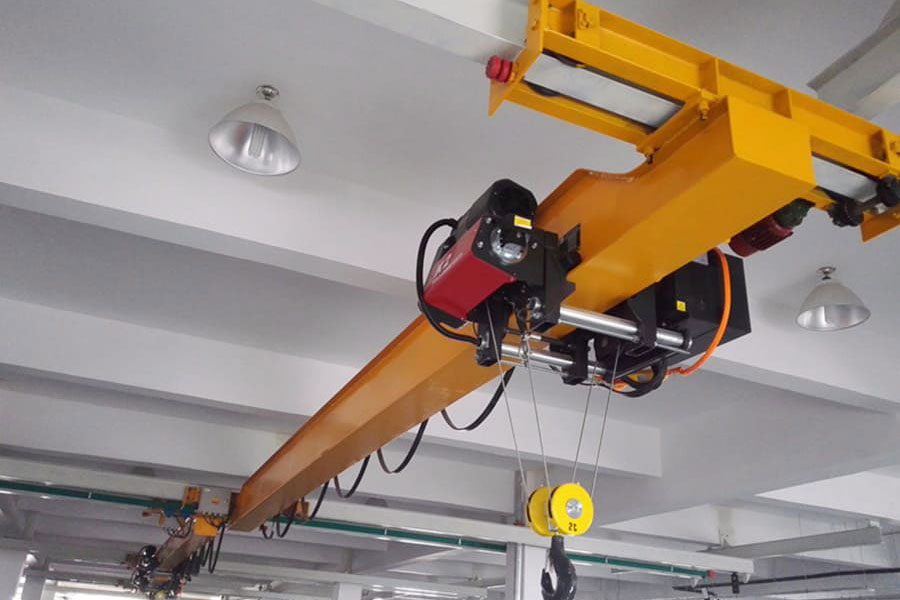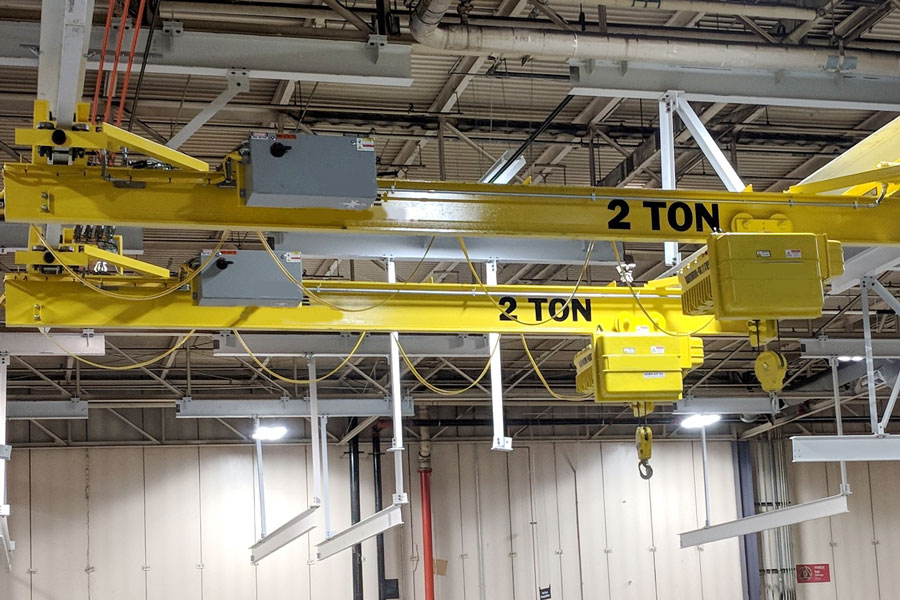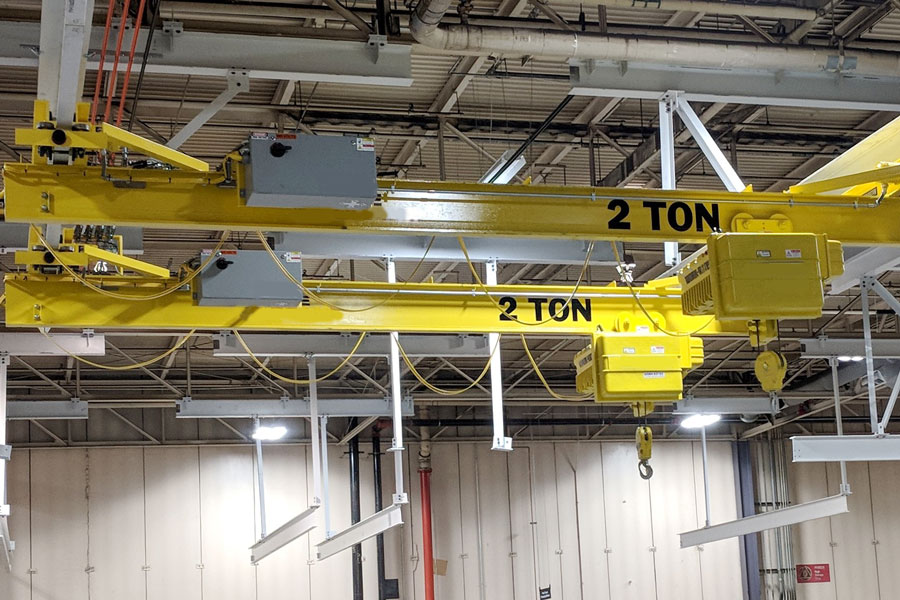이 웹사이트는 귀하에게 가능한 최고의 사용자 경험을 제공하기 위해 쿠키를 사용합니다. 쿠키 정보는 귀하의 브라우저에 저장되며 귀하가 당사 웹사이트로 돌아올 때 귀하를 인식하고 당사 팀이 귀하가 가장 흥미롭고 유용하다고 생각하는 웹사이트 섹션을 이해하는 데 도움을 주는 등의 기능을 수행합니다.


SEVENCRANE underhung monorail crane is a major lifting and transportation equipment in the production logistics process, and its utilization efficiency is related to the production rhythm of the enterprise. At the same time, bridge cranes are also dangerous special equipment and may cause harm to people and property in the event of an accident.
The driver of the industrial underhung monorail crane is the most active and critical factor in the use of the overhead crane. The driver’s ability to operate the overhead crane is very important and is a major issue directly related to the company’s efficiency and safe production. The author summarizes his own practical experience in operating bridge cranes and puts forward the following operating experience based on the characteristics of bridge cranes.

Master the characteristics of equipment and work objects
To correctly operate a bridge crane, you must carefully master key elements such as the equipment principle, equipment structure, equipment performance, equipment parameters, and operating process of the equipment you are operating. These key factors are closely related to the use and operation of this equipment.
1. 장비의 원리를 숙지한다
원리를 주의 깊게 이해하는 것은 장비를 올바르게 작동하기 위한 전제 조건이자 기초입니다. 원칙이 명확하고 깊게 숙달되어야 이론적 기초가 확립되고 이해가 명확하고 심오해지며 운영 수준이 일정한 수준에 도달할 수 있습니다.
2. 장비 구조를 주의 깊게 숙지하세요
장비 구조를 주의 깊게 숙지한다는 것은 교량 크레인의 주요 구조 구성 요소를 이해하고 숙달해야 함을 의미합니다. 브리지 크레인은 특수 장비이며 그 구조에는 고유한 특성이 있으므로 주의 깊게 이해하고 숙달해야 합니다. 장비 구조를 주의 깊게 익히는 것은 장비에 익숙해지고 장비를 능숙하게 제어하는 핵심입니다.
3. 장비 성능을 주의 깊게 마스터하세요.
To carefully grasp the performance of the equipment is to master the technical performance of each mechanism of the top 10 underhung monorail crane for sale, such as the power and mechanical performance of the motor, the characteristic braking state of the brake, and the safety and technical performance of the safety protection device, etc. Only by mastering the performance can we better take advantage of the situation, scientifically control the equipment, delay the deterioration process, and prevent and reduce the occurrence of failures.
4. 장비 매개변수를 주의 깊게 익히십시오.
장비 매개변수를 주의 깊게 숙지한다는 것은 작업 유형, 작업 수준, 정격 리프팅 용량, 메커니즘 작업 속도, 스팬, 리프팅 높이 등을 포함하여 교량 크레인의 주요 기술 매개변수를 이해하고 숙달해야 함을 의미합니다. 장비가 다른 경우가 많습니다. 장비의 기술적 매개변수에 따라 성능에 차이가 있습니다. 장비를 정확하게 작동하려면 각 오버헤드 크레인의 정확한 매개변수 값을 주의 깊게 아는 것이 중요합니다.
5. 작업 프로세스를 신중하게 마스터하십시오.
Carefully mastering the operating process means mastering the steps and processes of the production operations served by the 브리지 크레인, and striving for the best design and reasonable operation of the lifting and transportation procedures used in various processes. Only by proficiently mastering the process flow can we master the operation rules, be confident and operate freely, so as to improve work efficiency, safety and reliability.

Grasp the status changes of the equipment
The warehouse underhung monorail crane cost is special equipment, and the operation and operation must ensure the technical status and intact condition of the bridge crane. During the operation of bridge cranes, they are affected by factors such as production conditions and environment. The functions and technical status determined during the original design and manufacturing may continue to change and be reduced or deteriorated. Therefore, the driver must carefully grasp the status changes of the equipment, conduct good operation control of the bridge crane, and perform maintenance and inspections carefully to prevent and reduce failures.
1. 장비의 상태 변화를 잘 파악한다
장비는 주의 깊게 관리되어야 합니다. 유지 관리 시스템의 요구 사항에 따라 교량 크레인의 모든 부품을 정기적으로 청소, 청소, 윤활, 조정 및 조이십시오. 언제든지 발생하는 다양한 문제를 적시에 처리하고 장비의 작동 조건을 개선하며 문제를 초기에 차단하고 과도한 손실을 방지합니다. 실습을 통해 장비의 수명은 유지 관리 정도에 따라 크게 좌우된다는 것이 입증되었습니다.
2. 장비의 상태 변화를 잘 파악한다
장비의 상태 변화를 주의 깊게 파악하고 장비를 확인할 수 있습니다. 교량크레인의 빈번한 점검이 필요한 부분을 이해하고 숙달하며, 부품점검 방법과 수단을 숙지한다.
3. Skills in monitoring equipment through senses
Skills in monitoring equipment through the senses, i.e. seeing, hearing, smelling, touching and feeling. “Visual” means to use vision to observe the surface of the equipment in order to detect intuitive defects and failures. “Listening” means relying on hearing to detect the status of the device. The driver operates in the cab and cannot see the operating conditions of the equipment on the bridge. Hearing becomes an important auxiliary safety means. When electrical appliances or mechanical equipment are operating normally, they generally only emit very light harmonic sounds, but when they are malfunctioning, they will make abnormal noises. Experienced drivers can determine the approximate location of the fault based on the different changes in the sound. Therefore, identifying diseases by sound should be one of the internal skills of a driver. “Smell” means relying on the sense of smell to detect the status of the device. The electrical coil of the bridge crane catches fire, and the brake pads smoke and emit a pungent odor that can be smelled from a distance. If you find any peculiar smell, you should stop the vehicle immediately for inspection to avoid causing fire or other major equipment accidents. “Touch” is to diagnose the abnormal status of the equipment through hand feeling. Drivers sometimes encounter abnormal conditions in equipment and are able to diagnose and determine the cause of the malfunction. “Feeling” here refers to feel. Drivers will feel information from all aspects when operating, and experience will tell you what is normal and what is abnormal. When drivers find that they feel different from usual at work, they should immediately trace the source to avoid future troubles.
Communicate carefully with ground support personnel
The use of operating bridge cranes to complete lifting tasks requires the cooperation of many people such as drivers, commanders, and rigging personnel. Sometimes its operating scope also includes other equipment and operators, so as a driver, you must carefully work with the ground. Communicate and cooperate well with the personnel. The work objects, equipment status, work instructions, and operating environment must be confirmed before proceeding.

The driver must confirm the command language with the ground personnel before operating. If the command language is not agreed upon, the operation cannot be carried out. The driver must concentrate when operating and operate according to the commander’s signals. Before each operation, the driver should ring the bell to remind the personnel at the operation site to pay attention. At the same time, pay attention to the situation around the lifting objects. No one is allowed to stay under the hoisted object, under the arm, or in the area where the hoisting weight rotates. When the line of sight between the driver and the hoisted object may be blocked during hoisting, the driver should carefully inspect the on-site environment within the hoisting range and confirm the hoisting path of the hoisted object before hoisting. During the hoisting process, the signal contact with the commander should be strengthened.
At the same time, the commander should stand within the driver’s line of sight to give commands to avoid hoisting safety accidents due to blocked sight. If there are only drivers and hookers working on site, the driver must work closely with the hookers and work in unison. When moving and lifting heavy objects, you should only follow the signal given by the hooker. However, no matter who sends the “stop” signal, you should stop immediately.





